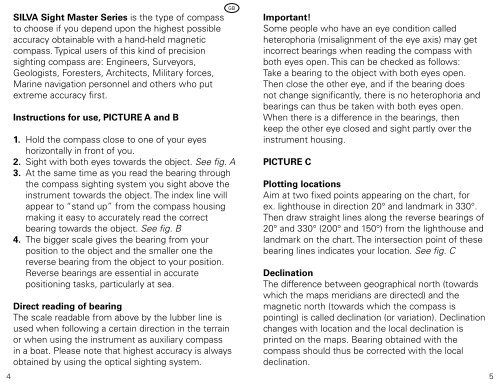Silva Sight Master
Silva Sight Master
Silva Sight Master
Create successful ePaper yourself
Turn your PDF publications into a flip-book with our unique Google optimized e-Paper software.
SILVA <strong>Sight</strong> <strong>Master</strong> Series is the type of compass<br />
to choose if you depend upon the highest possible<br />
accuracy obtainable with a hand-held magnetic<br />
compass. Typical users of this kind of precision<br />
sighting compass are: Engineers, Surveyors,<br />
Geologists, Foresters, Architects, Military forces,<br />
Marine navigation personnel and others who put<br />
extreme accuracy first.<br />
Instructions for use, PICTURE A and B<br />
1. Hold the compass close to one of your eyes<br />
horizontally in front of you.<br />
2. <strong>Sight</strong> with both eyes towards the object. See fig. A<br />
3. At the same time as you read the bearing through<br />
the compass sighting system you sight above the<br />
instrument towards the object. The index line will<br />
appear to “stand up” from the compass housing<br />
making it easy to accurately read the correct<br />
bearing towards the object. See fig. B<br />
4. The bigger scale gives the bearing from your<br />
position to the object and the smaller one the<br />
reverse bearing from the object to your position.<br />
Reverse bearings are essential in accurate<br />
positioning tasks, particularly at sea.<br />
Direct reading of bearing<br />
The scale readable from above by the lubber line is<br />
used when following a certain direction in the terrain<br />
or when using the instrument as auxiliary compass<br />
in a boat. Please note that highest accuracy is always<br />
obtained by using the optical sighting system.<br />
Important!<br />
Some people who have an eye condition called<br />
heterophoria (misalignment of the eye axis) may get<br />
incorrect bearings when reading the compass with<br />
both eyes open. This can be checked as follows:<br />
Take a bearing to the object with both eyes open.<br />
Then close the other eye, and if the bearing does<br />
not change significantly, there is no heterophoria and<br />
bearings can thus be taken with both eyes open.<br />
When there is a difference in the bearings, then<br />
keep the other eye closed and sight partly over the<br />
instrument housing.<br />
PICTURE C<br />
Plotting locations<br />
Aim at two fixed points appearing on the chart, for<br />
ex. lighthouse in direction 20° and landmark in 330°.<br />
Then draw straight lines along the reverse bearings of<br />
20° and 330° (200° and 150°) from the lighthouse and<br />
landmark on the chart. The intersection point of these<br />
bearing lines indicates your location. See fig. C<br />
Declination<br />
The difference between geographical north (towards<br />
which the maps meridians are directed) and the<br />
magnetic north (towards which the compass is<br />
pointing) is called declination (or variation). Declination<br />
changes with location and the local declination is<br />
printed on the maps. Bearing obtained with the<br />
compass should thus be corrected with the local<br />
declination.<br />
4 5




